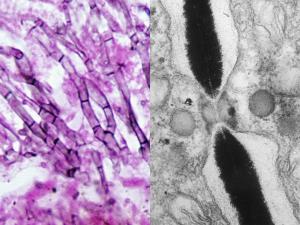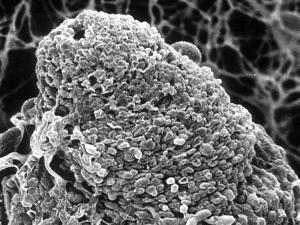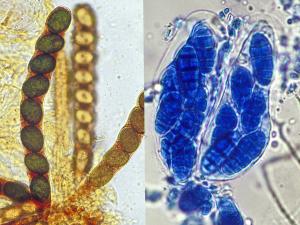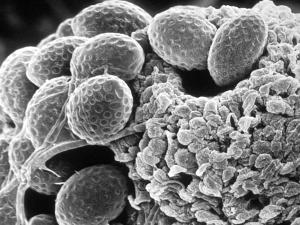Ascomycota
Ascomycota are commonly know as sac fungi, cup fungi, earth tongues, cramp balls, dung buttons, truffles or moulds.
Most common moulds belonging to the Hyphomycetes are ascomycetes. They may be saprobes, parasites (especially of plants), or lichen forming, mostly terrestrial; cosmopolitan (50 orders, 275 families, 3328 genera, 32,325 spp). Ascomycetes are characterized by septate hyphae with simple pores. Asexual reproduction by conidia. Sexual reproduction by ascospores, typically eight, in an ascus. Asci are often housed in a fruiting body or ascocarp e.g. cleistothecia or perithecia.
Click images below to expand:
Ascomycetes are characterised by having septate hyphae with simple septal pores showing characteristic Woronin bodies which can plug the pore in the event of injury to the hyphal segment. Asci are often housed in a fruiting body or ascocarp. The above photos show a perithecium (an ostiolate ascocarp) of Gelasinospora. Note the apical ostiole and ascospore discharge through the apical ostiole of a perithecium. Asci typically hold 8 ascospores and which may be single or multi celled.
Species descriptions
-
Aphanoascus flavescens
Aphanoascus fulvescens is a soil-borne keratinolytic ascomycete that occasionally causes dermatomycosis in humans and animals. It has a worldwide distribution and is more commonly found in keratin enriched soils from the degradation of animal hair and skin.
RG-2 organism.

Aphanoascus flavescens culture and cleistothecium.
Morphological description:
Colonies are moderately fast growing, white to tan with the production of numerous spherical, pseudoparenchymatous, buff to light brown cleistothecia (non-ostiolate ascocarps). Asci are subspherical to ellipsoidal and eight-spored. Ascospores light brown, yellowish to pale brown in mass, irregularly reticulate, lens-shaped, 3.5-4.7 x 2.5-3.5 µm. Aphanoascus fulvescens has a Chrysosporium anamorph showing typical pyriform to clavate-shaped conidia with truncated bases, 15-17.5 x 3.7-6 µm, which are formed either intercalary, laterally or terminally.
Aphanoascus fulvescens showing typical pyriform to clavate-shaped conidia with truncated bases.
Molecular identification:
ITS sequencing will differentiate most species. The calmodulin gene may also be useful (Cano et al. 2002, Halliday et al. 2015).Key features:
Keratinolytic, cleistothecia, and a Chrysosporium anamorph.References:
Domsch et al. (2007), McGinnis (1980), de Hoog et al. (2000, 2015), Cano and Guarro (1990), Cano et al.(2002). -
Chaetomium spp.
The genus Chaetomium contains between 160 and 180 species. All are saprophytic being isolated from soil, straw, dung and plant debris. Several species are thermophilic and can grow at temperatures above 37C. Chaetomium species are important agents for the decomposition of cellulose waste and plant materials, and are only rarely isolated in medical mycology laboratories.
RG-1 organisms.

Chaetomium spp. ascocarps (perithecia) and ascus with ascospores.
Molecular identification:
Lee and Hanlin (1999) established the phylogenetic relationships of Chaetomium based on ribosomal DNA sequences. Sequencing of the β-tubulin and RPB2 genes is recommended for routine identification (Wang et al., 2016, 2022).Key features:
Ascomycete producing darkly-pigmented ostiolate perithecia beset with long dark terminal setae.References:
Ames (1963), Seth (1970), Millner (1975), Domsch et al. (2007), Ellis and Keane (1981), Ellis (1981), von Arx (1986), de Hoog et al. (2000, 2015).Antifungal susceptibility: Chaetomium species (Australian national data); MIC µg/mL. Antifungal No ≤0.016 0.03 0.06 0.125 0.25 0.5 1 2 4 ≥8 AMB 8 5 2 1 ISAV 3 1 1 1 VORI 8 1 3 2 1 1 POSA 8 1 1 4 1 1 ITRA 8 2 5 1




